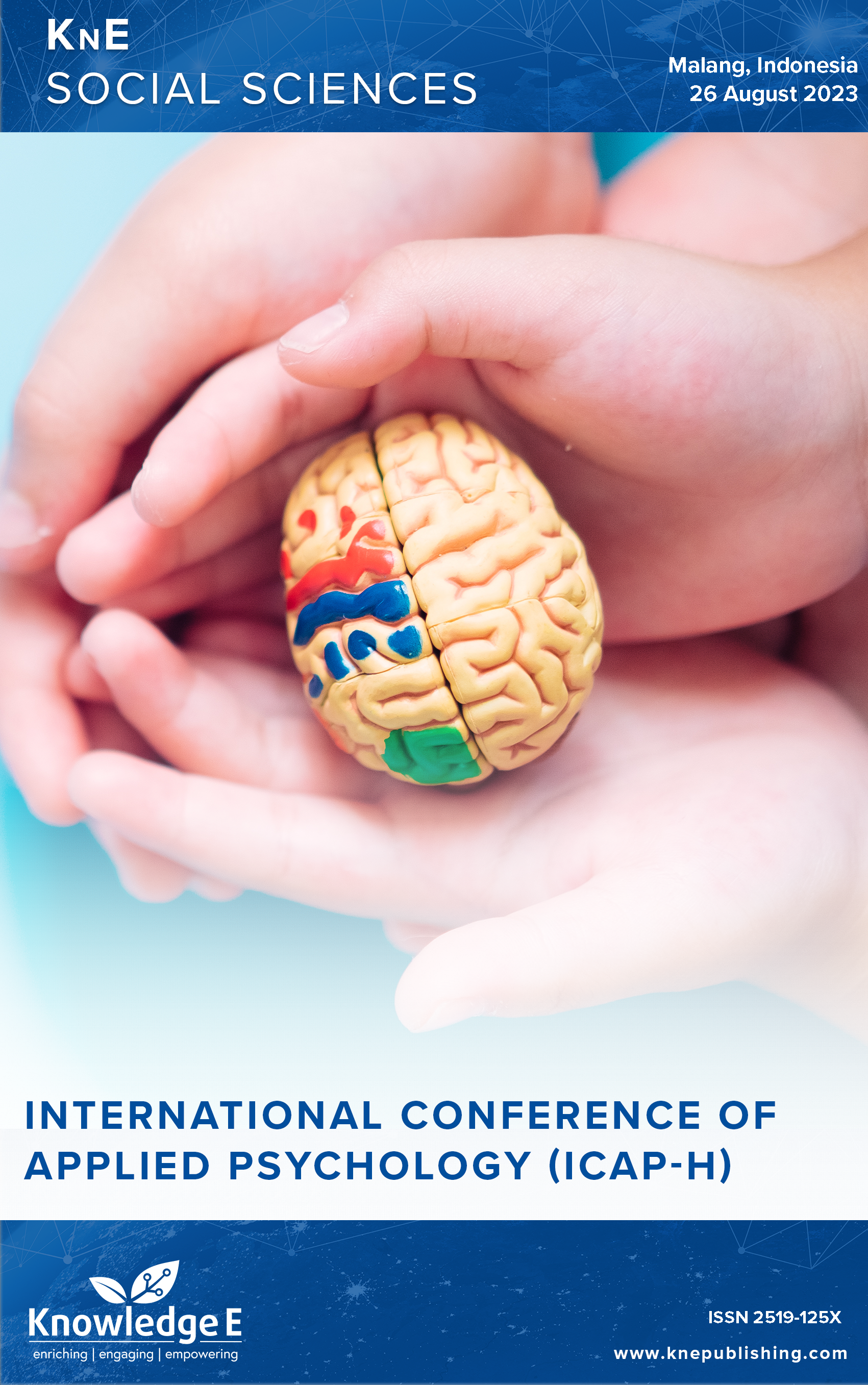The Effects of Virtual Reality on Ailurofobia
DOI:
https://doi.org/10.18502/kss.v9i5.15158Abstract
Specific phobia is a type of childhood anxiety disorders that affects 20% of children and adolescents worldwide. Therefore, more in-depth research is necessary, especially considering the progressions in tools within the latest technology. The current study tested virtual reality to explore its function in substituting the fear stimulus in people with specific phobia. Given that the goal of this study is to provide both qualitative descriptions and quantitative statistics, the mixed-method research design used in it is seen to be the most efficient. The subjects included young adults that undergo ailurophobia, or a severe fear of cats. Snowball sampling instrument is employed for the sampling using scale (Severity Measure for Specific Phobia-Adult). The findings show that encountering a cat in real life and in virtual reality had no different levels of fear, which means virtual reality is capable of substituting the role of a real cat. In most statements, the participants claimed that the virtual reality cat animation made them fear for their safety.
Keywords: ailurophobia, virtual reality
References
American Psychiatric Association. Severity Measure for Specific Phobia—Adult. American Psychiatric Association; 2013.
Carl E, Stein AT, Levihn-Coon A, Pogue JR, Rothbaum B, Emmelkamp P, et al. Virtual reality exposure therapy for anxiety and related disorders: A meta-analysis of randomized controlled trials. Journal of Anxiety Disorders. 2019;61:27–36. DOI: https://doi.org/10.1016/j.janxdis.2018.08.003
Diagnostic And Statistical Manual of DSM-5 ?? ?? . (n.d.).
Essau CA, Conradt J, Petermann F. Frequency, comorbidity, and psychosocial impairment of anxiety disorders in German adolescents. Journal of Anxiety Disorders. 2000;14(3):263–279. DOI: https://doi.org/10.1016/S0887-6185(99)00039-0
Fodor LA, Cote? CD, Cuijpers P, Szamoskozi ?, David D, Cristea IA. The effectiveness of virtual reality based interventions for symptoms of anxiety and depression: A meta-analysis. Scientific Reports. 2018;8(1):10323. DOI: https://doi.org/10.1038/s41598-018-28113-6
Gul S, Bokhari SWA. Ailurophobia-irrational fear of cats with possible treatment spotlights to a prevailing disorder. Hamdard Journal of Pharmacy. 2022;2(2). https://doi.org/10.61744/hjp.v2i2.28 DOI: https://doi.org/10.61744/hjp.v2i2.28
Hersen M, Last CG, editors. Child behavior therapy casebook. Springer US; 1988. https://doi.org/10.1007/978-1-4613-0993-2 DOI: https://doi.org/10.1007/978-1-4613-0993-2
Lei C, Sunzi K, Dai F, Liu X, Wang Y, Zhang B, et al. Effects of virtual reality rehabilitation training on gait and balance in patients with Parkinson’s disease: A systematic review. PLoS One. 2019;14(11):e0224819. DOI: https://doi.org/10.1371/journal.pone.0224819
Lieb R, Miché M, Gloster AT, Beesdo-Baum K, Meyer AH, Wittchen HU. Impact of specific phobia on the risk of onset of mental disorders: A 10-year prospectivelongitudinal community study of adolescents and young adults. Depression and Anxiety. 2016;33(7):667–675. DOI: https://doi.org/10.1002/da.22487
London LS. Ailurophobia and ornithophobia. Psychiatric Quarterly. 1952;26(3):364– 371. DOI: https://doi.org/10.1007/BF01568473
Morina N, Ijntema H, Meyerbröker K, Emmelkamp PM. Can virtual reality exposure therapy gains be generalized to real-life? A meta-analysis of studies applying behavioral assessments. Behaviour Research and Therapy. 2015;74:18–24. DOI: https://doi.org/10.1016/j.brat.2015.08.010
Oar EL, Farrell LJ, Ollendick TH. Specific phobia. Pediatric anxiety disorders. Elsevier; 2019. 127–150 p. DOI: https://doi.org/10.1016/B978-0-12-813004-9.00007-4
Olatunji BO, Cisler JM, Deacon BJ. Efficacy of cognitive behavioral therapy for anxiety disorders: A review of meta-analytic findings. Psychiatric Clinics of North America. 2010;33(3):557–577. DOI: https://doi.org/10.1016/j.psc.2010.04.002
Peristianto SV, Astuti K. Decreasing symptoms of specific phobias with cognitive behavior therapy. Malaysian Mental Health Journal (Mmhj). 2022;1(1):12–14. DOI: https://doi.org/10.26480/mmhj.01.2022.12.14
Powers MB, Emmelkamp PM. Virtual reality exposure therapy for anxiety disorders: A meta-analysis. Journal of Anxiety Disorders. 2008;22(3):561–569. DOI: https://doi.org/10.1016/j.janxdis.2007.04.006
Purwaningtyas FD. Intervensi psikologi perilaku maladaptive: Metode Cbt Pada Penderita Fobia Kolam Renang Atau Pantai (Air) [ Jurnal Penelitian Dan Pemikiran Psikologi]. Psikosains. 2020;15(1):1. DOI: https://doi.org/10.30587/psikosains.v15i1.1997
Salehi E, Mehrabi M, Fatehi F, Salehi A. Virtual reality therapy for social phobia: A scoping review. Digital Personalized Health and Medicine. 2020:713–717.
Sue D, Sue D. Sue revised by Fred Whitford SW, Wing Sue D, Sue S. HOUGHTON MIFFLIN COMPANY BOSTON NEW YORK Instructor’s Resource Manual Understanding Abnormal Behavior Eighth Edition. 2006.
Suryaningrum Cognitive Behaviour Therapy (CBT) untuk Meningkatkan Gangguan. (n.d.).
Wechsler TF, Kümpers F, Mühlberger A. Inferiority or even superiority of virtual reality exposure therapy in phobias?—A systematic review and quantitative meta-analysis on randomized controlled trials specifically comparing the efficacy of virtual reality exposure to gold standard in vivo exposure in agoraphobia, specific phobia, and social phobia. Frontiers in Psychology. 2019;10:1758. DOI: https://doi.org/10.3389/fpsyg.2019.01758
Zhang Q, Fu Y, Lu Y, Zhang Y, Huang Q, Yang Y, et al. Impact of virtual reality-based therapies on cognition and mental health of stroke patients: Systematic review and meta-analysis. Journal of Medical Internet Research. 2021;23(11):e31007. DOI: https://doi.org/10.2196/31007

